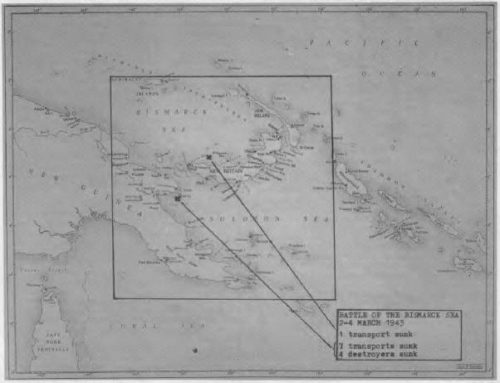- Author
- Hordern, Marsden
- Subjects
- WWII operations
- Tags
-
- RAN Ships
- None noted.
- Publication
- June 1993 edition of the Naval Historical Review (all rights reserved)
Apart from the three destroyers which had been busy pulling men from the water that night, there was other naval activity in the area. American torpedo boats sped north from their base at Tufi, ranged the battlefield, found the disabled OIGAWA MARU and sunk her. They then shot up barges and boats killing many Japanese in the water. Early next morning searching American bombers sank the crippled destroyer ARASHIO.
But large numbers of Japanese troops were still adrift off the New Guinea coast with a chance to get ashore and fight again. Then, Douglas Gillison tells us in his Royal Australian Air Force, 1939-1942:
‘There was a terrible yet essential finale: Beaufighters, Bostons and Mitchells swept to and fro over the waters of the Huon Gulf seeking out and destroying barges and rafts crowded with survivors from the sunken enemy ships. It was grim and bloody work for which the crews had little stomach. Some of the men in the Beaufighter crews confessed to experiencing acute nausea.‘
The shocked Japanese acknowledged defeat and called for submarine assistance to rescue survivors. Days later the submarines 1-17 and 1-26 found one hundred and seventy men, and on 8 March fifty-four others who had reached an islet west of Goodenough Island were discovered there by 1-26.
These soldiers had been through an ordeal which few can comprehend. When they clambered or were lifted aboard the 1-26, they might have hoped to be taken back to Rabaul, to medical attention, sufficient fresh water, rest, rice, and perhaps some saki. But with its fragile and exhausted freight, 1-26 set course for Lae, and on 11 March, nine days after they had been blown into the Bismarck Sea, these wretched survivors were back again in the front line.

A sequel to the battle provided a windfall for the Allies. At this time soldiers of the Australian 47th Battalion were on Goodenough Island, and for days after the battle groups of survivors found their way there. Between 8 and 14 March Australian patrols on Goodenough Island killed seventy-two, captured forty two, and found nine men dead on a raft. And when two more boats landed, a patrol stalked and killed their eight occupants. The uniforms on some of the bodies showed them to have been senior officers, and in the boats were a number of sealed tins. They contained classified Japanese army documents which proved to be a complete Japanese Army list giving a detailed picture of its composition and revealing the existence of many unknown units.
Extravagant claims were made by some Allied sources that more than eighteen thousand Japanese were lost and sixty-eight fighters shot down for the cost of thirteen men and seven allied planes. But a tally of three thousand Japanese dead seems to be nearer the truth. Three thousand eight hundred were rescued by destroyers and two hundred and seventy-five by submarines.
The sinking of the KEMBU MARU, full of aviation petrol, ended plans for a Japanese air assault on our own men which must have claimed many lives. From this point on only a trickle of supplies got through to the Japanese army in New Guinea which had to be moved by night along the coast in barges. American PT boats and Royal Australian Navy Fairmiles would play a part in dealing with some of this clandestine traffic. But, above all, this battle brought home a great irony to the Japanese. The pendulum had swung against them. Their powerful base at Rabaul, established to threaten the allies in New Guinea, was now itself under threat, and they had to transfer four hundred carrier-based fighters to Rabaul to support their army in New Guinea. This affected their operations elsewhere in the Pacific.
On 16 March 1993, A.B.C. television ran a short feature to commemorate the fiftieth anniversary of the Battle of the Bismarck Sea. It screened a few feet of the film Damien Parer had taken from low-flying Beaufighter A19-5, piloted by Flight Lieutenant R.F. Uren. Australians salute the memory of their airmen who fought in this battle but the Americans commanded the greatest resources there and did most to gain the victory. The A.B.C. did not mention this, and its curious statement that `the RAAF pilots were helped in the battle by the Americans’, reflects the quality of its research.
Sources:
Bleakley Jack – The Eaves Droppers – AGPS Canberra 1992.
Buggy Hugh – Pacific Victory – Australian Ministry for Information n.d.
Gill G. Hermon – Royal Australian Navy 1942-1945 – AWM Canberra 1968.
Gillison Douglas – Royal Australian Air Force 1939-1942 – AWM Canberra 1962.
McAulay Lex – To the Bitter End – Random House, Sydney, 1992.
McAulay Lex – Battle of the Bismarck Sea – St. Martin’s Press, New York, 1991.
Mayo Lida – Bloody Buna – Purnell Book Services, London n.d.
Odgers George – Air War Against Japanese 1943-1945 – AWM Canberra 1957.
Wigmore Lionel – The Japanese Thrust – AWM Canberra 1957.
Personal interviews with RAAF aircrew who fought in the Battle of the Bismarck Sea.




